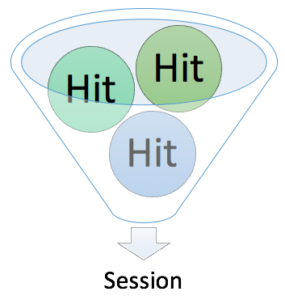Confused by terms like hit, session, filter, and segments when trying to read and understand Google Analytics reports? Is the terminology all Greek to you? Well have no fear, we will have you fluent in no time with our definitions and examples below!

Fig. 1: Hits creating a Session
Hit
A hit is a collection of small interactions on a web page(s) by one user. Hit types include page tracking hits, event tracking hits, and e-commerce hits.
For example, Judy comes to your yoga studio website to visit your site and possibly sign up for a studio membership. Judy looks around, checks out a number of pages, watches some yoga video previews, signs up to become a member, checks out, and leaves the site.
From a Google Analytics perspective, this is what is happening when Judy is on your site:
Interaction #1 – Judy navigates to the home page URL. Google Analytics processes this interaction by sending data to Google Analytics, which records this as one “hit.” GA continues to process Judy’s interactions:
Hit #2: “Judy just requested a yoga page.”
Hit #3: “Judy started a preview video.”
Hit #4: “Judy selected a membership.”
Hit #5: “Judy started the checkout process.”
Hit #6: “Judy left the site.”
These six hits create a session.
Session
A session is a group of interactions (hits) that take place on your site within a given time frame. Multiple screens or page views, events, video plays, and membership transactions can be contained in an individual session. Multiple sessions can be opened by a single user and these sessions can occur on the same day or over several days, weeks, or months. When one session ends, an opportunity to start a new session is created.

There are two methods to end a session:
Time-based expiration (including end of day):
• After 30 minutes of inactivity
• At midnight
Campaign change:
• If a user arrives by a campaign, leaves, and then comes back by way of a different campaign.
Time Example:
- The minute Judy hits your site, Google Analytics starts counting.
- The session ends in 30 minutes if Judy does not interact with the site.
- However, every time Judy interacts with the site (pages, events, goes to another page) Google Analytics resets the 30-minute timer by adding an additional 30 minutes from the time of the interaction.
From a Google Analytics perspective, this is what is happening when Judy is on your site:
Session example #1:
- Judy navigates to the home page URL.
- GA processes this interaction by starting a session with a 30-minute timer.
- Judy continues to look at pages and videos for 25 minutes.
- GA sees this as 1 session (so far).
- Judy puts down her laptop and takes her dog for a 45-minute walk in the park.
- Judy comes back and starts to watch a video.
- GA sees this as a new session.

Session example #2:
- Judy navigates to the home page URL.
- GA processes this interaction by starting a session with a 30-minute timer.
- Judy continues to look at pages and videos for 25 minutes.GA sees this a 1 session (so far).
- Judy pauses a video and leaves for a 29-minute break.Judy comes back and continues to watch the video.
- GA sees this as the same session.

Campaign example: Every time a user’s campaign source changes, GA starts a new session.
From the Google Analytics perspective, this is what is happening when Judy is on the site:
Campaign example #1:
- Judy comes to your site by a Paid Search campaign.
- GA starts a new session.
Campaign example #2:
- Judy comes to your site by an Email campaign.
- GA starts a new session.
Filters and Segments
In Google Analytics, a Property is the main account which determines which data is organized and stored together. Views are subset reports of the property and are created with filters applied.
Filters
- Are used primarily to include or exclude data from a view.
- Are a way of asking for individual pieces of information.
- Are constructed at the Admin View Level
Views can and most likely will have multiple filters applied. Once data is run through a filter, it is “irreversible” for that view. The data is then processed into the reports you access via the Google Analytics reporting interface.
Filter examples:
- Traffic that is Logged In
- Traffic that is Not Logged In
- Traffic from a specific host
- Traffic from a specific IP

Fig 2: View “Logged In”

Fig. 3: View “Not Logged In”
Segments
- Are a way to isolate a subset of your visitors (users) or visits (sessions) based on behavioral parameters (e.g., geography, visit recency, or conversion abandonment).
- Are meant as a way to focus on different sessions or user behaviors to highlight patterns and insights.
- Work differently than filters because they apply to all existing data in your view.
- Once applied, only show the part of the traffic that matches the specified user or session behavior.
- Work in read-only mode so you can create as many segments without risking to destroy/corrupt data going forward.
When you ask Google Analytics to give you some data for an advanced segment, GA hears you say: “Show me all the visits in which condition X (and/or other conditions) happened.” What you get is data for those conditions and everything else that happened in those visits. Sampling sometimes occurs when you apply a segment. Segments should be used for AdHoc analysis.

Need help interpreting your Goggle Analytics reports? Contact your InfoTrust Consultant today!
